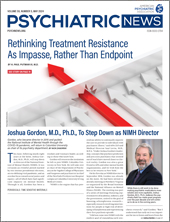What does the long-term trajectory look like for young people at high risk for developing psychosis and schizophrenia?
In tandem with the search for biomarkers that might more clearly delineate those who will experience psychosis and those with a more benign course, understanding the trajectory of at-risk individuals is the subject of at least two major projects at the National Institute of Mental Health and numerous research endeavors worldwide.
Identifying those young people who may go on to develop full-blown psychosis (or “convert”) and are most urgently in need of intervention is, naturally, of intense interest to researchers and clinicians. But youth at very high risk who are not destined to experience psychosis are no less important: What variables—genetic, familial, neurobiological, and/or experiential—distinguish them from those who convert to psychosis?
Moreover, while there is a subset of high-risk individuals who appear to remit, most young people who have met high risk criteria continue to experience significant mental illness, and many still meet high-risk criteria years later.
A
report in the February
Schizophrenia Bulletin found that more than half of individuals at “ultrahigh risk” (UHR) of psychosis who did not convert to psychosis over a six- to 12-year period continued to have a persistent nonpsychotic mental disorder six to 12 years later, and a third also developed a nonpsychotic mental disorder. More than a quarter still met ultrahigh-risk criteria.
Ultrahigh risk refers to youth or young adults who experience a range of brief, intermittent psychotic symptoms and/or subthreshold psychotic experiences, putting them at greatly increased odds of developing frank psychosis or schizophrenia. UHR status was determined using the Comprehensive Assessment of At-Risk Mental States (CAARMS).
The researchers evaluated 102 young people (62% female) enrolled in the Personal Assessment and Evaluation Clinic, a specialized clinic for high-risk youth at Orygen, a youth mental health center in Melbourne, Australia. All participants were between 15 and 30 years of age at baseline and met the criteria for UHR but had not converted to full-blown psychosis at a follow-up assessment six to 12 years after their baseline assessment.
Overall, 54% of participants had a nonpsychotic disorder that persisted from baseline to follow-up, and 35% were diagnosed with a new nonpsychotic disorder during the follow-up period. The disorder that was the most persistent over time was mood disorder. Additionally, of the 84 patients for whom data were available on UHR status at follow-up, 29% continued to meet UHR criteria and were more likely to have a co-occurring mental disorder.
Kristin Cadenhead, M.D., is a professor of psychiatry at the University of California, San Diego, and director of the university’s Early Psychosis Treatment Program. She reviewed the report for Psychiatric News and said the relatively long follow-up period in the Australian study is an important contribution; most previous studies have had follow-up periods of two to three years.
“These results confirm that there is a large percentage of at-risk people who remain symptomatic more than six years after baseline and still have a high rate of comorbid psychiatric diagnoses, predominantly depression and anxiety,” she told Psychiatric News. “And those who have comorbid psychiatric diagnoses are typically functioning more poorly than those who are in remission.”
She said the majority of high-risk patients are help-seeking individuals in need of treatment regardless of whether they convert to psychosis. “Given the level of comorbidity, many [of those who do not convert] are often receiving some level of treatment,” she said. “Cognitive-behavioral therapy has the best evidence, and it is effective as a broad-spectrum treatment for depression, anxiety, and more generally the stress of being a teenager.”
Biomarker Studies Follow the Trajectory of High-Risk Patients
Cadenhead noted that Patrick McGorry, M.D., a co-author of the Australian study, was an early pioneer of the effort to understand the “prodrome”—the developmental period that precedes frank psychosis. As early as the 1990s, McGorry had made the case for “staged-treatment,” advocating for the least-invasive approach (a “soft landing”) for those at the earliest stage. He is the founder of Orygen in Melbourne.
Thirty years later there is a thriving research endeavor in the United States, Europe, Asia, and Australia aimed at the early identification of high-risk individuals, now coupled with a search for biomarkers that might more definitively predict the various trajectories of high-risk patients. For instance, a March study in AJP in Advance by Yongqing Hou, Ph.D., and colleagues found that at-risk individuals who later develop full-blown psychosis respond more slowly to visual stimuli than high-risk individuals who do not—suggesting that this neurophysiologic measure may be a marker for psychosis.
The Accelerating Medicines Partnership Schizophrenia (also referred to as AMP SCZ) is a five-year joint venture of NIMH, the Foundation for the National Institutes of Health, the National Alliance on Mental Illness, the pharmaceutical industry, and other nonprofit and private organizations—including the APA Foundation—to identify similar biomarkers of risk for schizophrenia and other outcomes (see box).
NAPLS was established in 2003 as a consortium of eight NIMH-funded high-risk clinics. In 2008, the NAPLS consortium was awarded a five-year grant from NIMH to incorporate biological assessment approaches (neuroimaging, electrophysiological, hormonal, and genomic) into a multisite prospective, longitudinal study. A ninth clinic was added at the University of California, San Francisco. Cadenhead is director of the NAPLS clinic at the University of California, San Diego, known as the
Cognitive Assessment and Risk Evaluation, or CARE Program.
She said the aim of the Predictors and Mechanisms Project is to conduct follow-up assessments for up to 2,000 high-risk patients enrolled at NAPLS clinics. “The idea is to determine how many have converted to psychosis after at least five years and find out what has happened to those who do and do not convert and if there are predictors of a good versus poor course of illness from early in the prodromal period,” she told Psychiatric News. “Over the years we have collected biomarkers—brain imaging, neurophysiologic measures, blood for DNA, and immune response—that will help to understand the neuropathology as well as assist in predicting later psychosis.”
Other important questions include whether converters go on to develop affective or nonaffective psychoses and how treatment or drug use impacts outcome among the entire cohort. Cadenhead will be presenting preliminary data on the project at the meeting of the Society for Biological Psychiatry in Austin, Texas, this month.
Do Conversion Rates Increase With Longer-Follow-up?
A striking observation from 20 years of prodromal research, noted in the Australian Schizophrenia Bulletin study, is that conversion rates have fallen from the earliest days when rates were as much as 35%. This may be due to the fact that clinics providing care to high-risk patients began over time to attract less acutely ill patients: patients were originally referred from hospitals or by physicians, but increasingly clinics began recruiting through community advertising and other outreach efforts.
Intriguingly, however, Cadenhead said very early data from the NIMH study she is leading is showing a surprising number of converters at the five-year follow-up mark. “The lore has been that most people convert within the first year or two—between 20% and 25%,” she said. “But with longer follow-up, we may find another 8% or 9% converting after five years.”
She said the NIMH study is one of the few opportunities to follow the full trajectory of all at-risk young people—those who convert, those who have a more benign course, and those who remit—and determine if there is something in their background that might influence where they are today. “It’s going to tell us a lot about those who don’t convert—are they more resilient? Do they have protective factors?” ■

